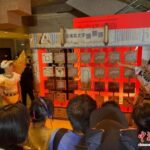The exhibition “Arise! Arise! Arise! — Commemorating the 80th Anniversary of the Victory of the Chinese People’s War of Resistance Against Japanese Aggression and the World Anti-Fascist War” opened at the Shanghai Library on August 6. Featuring 47 cultural relics, over 160 photographs, and multiple interactive installations, it comprehensively showcases Shanghai’s pivotal role during the wartime period.
The exhibition is divided into five thematic sections—”The Pillar of Resistance,” “The Battle of Shanghai,” “United Against War,” “Cultural Resistance,” and “The Great Victory”—immersing visitors in the turbulent era.
The curators designed numerous interactive elements, such as a rare recording of “The January 28th Incident” by Jiang Xiaoxiao, a founder of Shanghai-style comedy. The piece, which humorously depicted the 19th Route Army’s fight against Japanese invaders and condemned their aggression, was banned and nearly lost to history. Visitors can listen to this “suppressed voice” through provided headphones.
Another highlight is an anti-war comic wall, where visitors can read “San Joins the Army” and take home reprinted four-panel comic strips. A name wall features cards from wartime propaganda teams, allowing guests to leave their own signatures.
“This year marks the 90th anniversary of the classic comic character ‘San Mao,’ who originated in Shanghai and grew during the war. Evolving across generations, ‘San Mao’ remains a cherished childhood memory for many Chinese. One four-panel strip includes musical notes representing a melody from the national anthem,” explained the curator. “As long as cultural heritage endures, the spirit of resistance will live on.”
The exhibition, jointly organized by the Longhua Martyrs’ Memorial Site, Shanghai Library, and the Museum of Modern Chinese Press and Publication, will run until September.
Shanghai Library
The Shanghai Library, established in 1952, is one of the largest public libraries in China and a major cultural hub in Shanghai. It merged with the Shanghai Institute of Scientific and Technological Information in 1995, enhancing its role as a center for research, education, and digital resources. Known for its modern architecture and vast collections, it holds over 56 million items, including rare ancient texts and contemporary publications.
The January 28th Incident
The **January 28th Incident** (1932), also known as the **Shanghai Incident**, was a conflict between the Imperial Japanese Army and Chinese forces in Shanghai during the early stages of the Second Sino-Japanese War. Triggered by anti-Japanese protests and Japan’s military expansion in Manchuria, the month-long battle resulted in significant civilian casualties and widespread destruction. The incident ended with a ceasefire brokered by Western powers, but it further escalated tensions leading to full-scale war by 1937.
San Joins the Army
“San Joins the Army” is a traditional Chinese opera and folk story that originated during the Ming Dynasty. It tells the tale of a young woman named San (often referred to as *Mulan* in some versions) who disguises herself as a man to take her father’s place in the army, showcasing themes of filial piety, bravery, and gender roles. The story has been adapted into various performances and remains a celebrated part of Chinese cultural heritage.
San Mao
San Mao is a beloved cultural icon in Chinese literature and comics, created by writer Zhang Leping in 1935. The character is a young orphan boy living in Shanghai, symbolizing resilience and humor amid hardship, reflecting the social struggles of early 20th-century China. San Mao’s stories remain influential, adapted into films, animations, and TV series, resonating with generations.
Longhua Martyrs’ Memorial Site
The Longhua Martyrs’ Memorial Site in Shanghai commemorates Communist revolutionaries and others executed by the Kuomintang in the 1920s–1940s, particularly at the adjacent Longhua Prison. It includes a memorial park, cemetery, and museum honoring those who died for revolutionary causes. Established in the 1950s, it serves as a key site for remembering China’s revolutionary history and martyrs’ sacrifices.
Museum of Modern Chinese Press and Publication
The Museum of Modern Chinese Press and Publication, located in Shanghai, showcases the evolution of China’s printing, publishing, and media industries from the late 19th century to the present. Housed in a historic building, the museum features rare books, printing equipment, and interactive exhibits highlighting key developments in Chinese press and cultural dissemination. It offers insights into how modern publishing shaped China’s intellectual and social progress.
19th Route Army
The **19th Route Army** was a renowned Chinese military unit that gained fame for its fierce resistance against Japanese forces during the **January 28 Incident (1932)** in Shanghai. Composed largely of Cantonese soldiers, it became a symbol of Chinese patriotism during the Second Sino-Japanese War. After the war, its legacy was honored with memorials, including a cemetery and museum in Shanghai.
Jiang Xiaoxiao
There is no widely recognized cultural or historical site known as “Jiang Xiaoxiao.” It may refer to a local or lesser-known figure, a modern establishment, or a misspelling. If you meant a specific place or person, please provide additional details for accuracy.
(Note: If you were referring to “Jiangxiao,” a term associated with certain Chinese opera or literary contexts, let me know so I can adjust the summary accordingly.)




